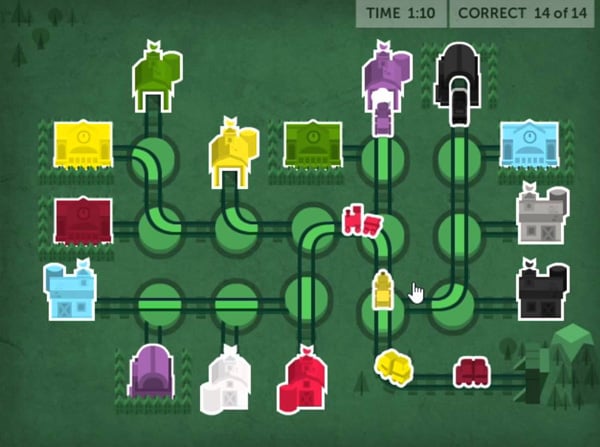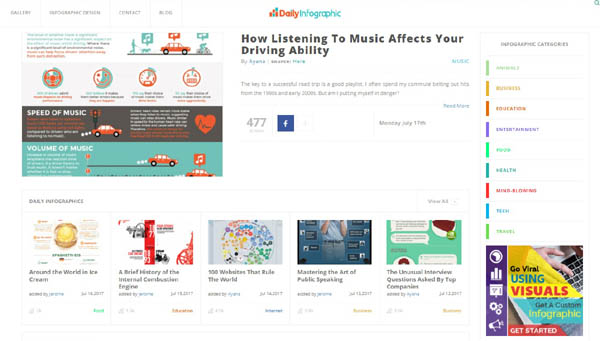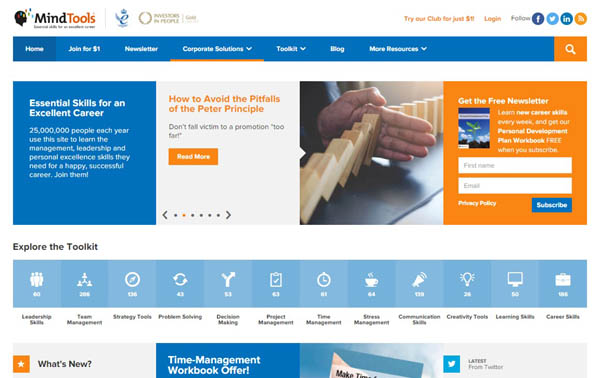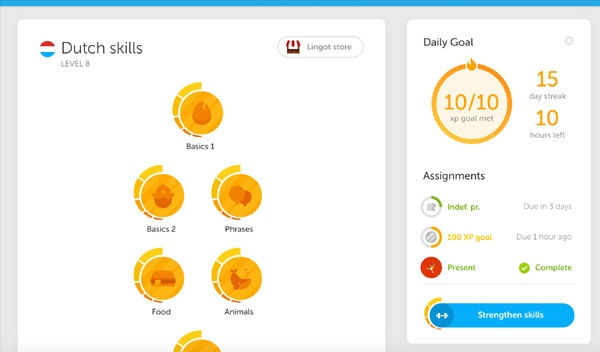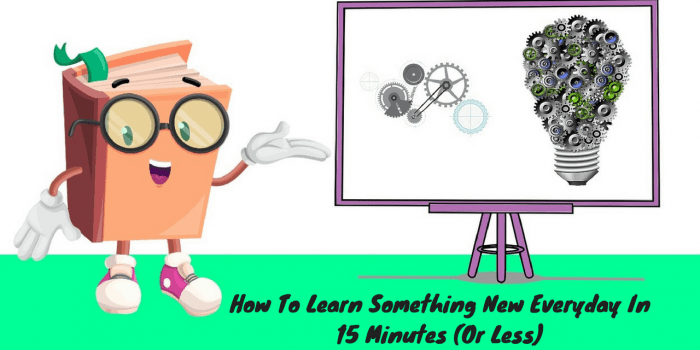
*This post contains affiliate links. Signing up for some of these services may send commissions to us at no extra cost to you. It helps to sustain the time,effort, and love we put into this site. Thanks!
As children we were encouraged to learn something new every day. We did experiments at school, took part in extra-curricular activities, and joined cultural and activist groups during our college years.
Then something happened:
Adulthood. (Or really, adulting.)
We went from being curious children to adults dedicated to a 9-5 job (which the majority of us find unrewarding), adopting routines that rarely ever change.
Benedict Carey, author of the book How We Learn, says that routine limits our brain’s ability to learn new skills and knowledge. This is worrisome because learning new things is important for our happiness.
Why Learning New Things Is Crucial for Happiness
You may have heard that the “brain is like a muscle.” Just like other muscles, you have to exercise the brain by learning new things. Yes, there is ample research which shows that learning helps build neuron connections and can stave off diseases like Parkinson’s. But there is a lot more to learning new things than just making the brain stronger. The act of learning actually makes us happier.
As Belle Beth Cooper writes about in her post on “Why New Things Make Us Feel So Good”, there is a section in the brain known as the SN/VTA.
The SN/VTA part of the brain is linked to the learning and memory parts, but it is best known as the “novelty center” because it lights up when exposed to new stimuli. You experience a rush of dopamine, which is one of the chemicals that motivates us towards rewards.
Here is what happens:
- You experience something new.
- The “novelty center” of your brain is activated.
- You get a rush of dopamine.
- Dopamine motivates you to follow through with the new thing.
- You get another rush of dopamine when you finish the activity.
It is no surprise then that research has found dopamine is closely linked to the learning process. In short, learning new things stimulates happiness chemicals brain.
Learning is fundamentally positive for your mental health.
Other Benefits of Learning Something New
- Learning Makes You More Interesting to Others: You’ll always have something to talk about at parties.
- Can Relate to More People: The more you know, the more likely you are to find something in common with others. Empathy also helps bridge gaps in communication.
- Builds Self-Esteem: Practice makes perfect, and when we see ourselves mastering new knowledge and skills, we build self-efficacy. Self efficacy is our own faith that we can succeed at a given task, which closely overlaps with self-esteem and confidence.
- You’ll Make More Friends: Because of the benefits of learning listed above, you’ll find it easier to meet people and make friends. Social interactions are essential for our happiness, so learning really does pay off in the long run!
- Sets a Good Example: If you want your kids and loved ones to reap the same benefits of learning, lead by example! Show them the importance of education by dedicating time to activities like reading books, exploring scientific concepts, and even working on a research paper that cultivates analytical thinking, enhances problem-solving abilities, and advances knowledge in various fields. Education is paramount as it equips individuals with the knowledge, skills, and critical thinking abilities necessary for personal growth and societal progress.
- Earn More Money: Depending on what you learn, you might build both technical or soft skills to advance your career.
- Find a More Rewarding Career: It isn’t money which motivates us –having a sense of purpose motivates. Learning new skills makes you better-rounded so you can more easily find what you love to do.
- Empowering: Learning gives you the information you need to make better informed decisions in life.
- You’ll Learn Easier and Faster: The more you practice learning, the denser the myelin white matter of your brain becomes and the stronger your neural pathways become.
- Learning Fuels Creativity: As Positive Psychology champion Vanessa King says, ideas come from seemingly unrelated things. Learning new things can trigger ideas in other areas.
How to Learn Something New Right Now
Learning can be broken down into short-term and long-term learning. If you don’t necessarily want to embark on a big endeavor (such as learning to play an instrument), your brain can still benefit from learning smaller bits of information on a daily basis. Here are some ways to do that.
1. Watch Ted ED
Ted Talks are famous for bringing a huge amount of topics by innovative thinkers. Ted Ed takes learning a step further with engaging video lessons. Topics range from “the scientific way to cut a cake” to “how money laundering works.”
2. Play GeoGuessr
Americans are notoriously bad at geography, but the rest of the world probably isn’t too much better. The game GeoGuessr takes a unique approach to learning geography. You are shown a Google Maps photo and have to guess where it is. You might just find yourself saying things like, “Huh, I didn’t know that Afghanistan has such green forests!” It’s free to play.
3. Train Your Brain at Lumosity
Brought to you by scientists and game developers, Lumosity has a great collection of cognitive games you can play. You might not learn a concrete fact, but your brain will be challenged and grow!
4. Follow Curiosity
Curiosity is a website which inspires people to get smarter. They do it by finding the most interesting news on a variety of topics. Just click what topic you are interested in learning about and you’ll find fascinating articles and videos.
5. Build Your Vocabulary
A large vocabulary is not only impressive, but it allows you to express yourself better. Remember the book 1984 and how they started cutting words from the language as a form of mind control? Well, that’s the power of vocab! The website Vocabulary.com has come up with an adaptive learning game to help you learn more words easily.
6. Follow Daily Infographic
No brainer right? Humans process visuals quickly: It takes less than 1/10 of a second for your brain to get a sense of a visual. Absorbing new information using infographics is a quick and easy way to learn. Visual learning not only decreases comprehension time, but sticks around longer in our memories. On Daily Infographic you can spend 15 minutes per day perusing an infographic on a topic of your choice.
7. Encourage Yourself With Good Job, Brain! Trivia Podcast
Start your day off with an intelligent jolt of positively fascinating facts, offbeat trivia, and creative challenges designed to stimulate the mind. From identifying songs in reverse to the world’s weirdest history, Good Job, Brain! is the perfect podcast to enliven and inspire stimulated individuals.
8. Listen to 7 Good Minutes to Learn Yourself Better
Get yourself inspired and closer to your goals by listening to Clyde Lee Dennis’s self-improvement podcast. Each day of the week, he delivers practical life-skills discussions, wellness talks, and mindset shaping discourses into everything from stopping ruminating thoughts to goal-setting, the ego, and more.
9. Get Smart, Instantly With Instanerd
Subscribe to Instanerd or visit the site for an endless supply of useful facts and information. Start the feed and flick left or right through short how-tos and factoids on everything from taking advantage of travel opportunities to origin stories for society and social icons, fascinating general knowledge and even more obscure topics. Ever wondered what it’s called when you turn yellow from eating too many carrots? Instanerd has your answer.
10. Stay Informed With 60 Second Science
Scientific American’s 60 Second Science is the fastest way to stay informed regarding science, activism, and global interest issues. The refreshing, short format grips big topics, dissecting them during each podcast into condensed, relevant facts that fit great into any day regardless of how busy you may be.
11. Flex Your Mind For 5 Minutes Using Brain Training Podcast
Two games of three rounds each takes care of brain exercise for the day in under five minutes, thanks to the Brain Training Podcast. The show is described as an audio workout for your head that teaches you how to memorize things effectively while having fun.
12. Discover Unknown History By Listening To The Way I Heard It
Get the low-down on some of the most significant pop culture topics, the world’s greatest inventions, influential politics, prominent people, exciting places, and other icons of modern society. Mike Rowe’s podcast is short, to the point, and perfect for anyone with an enquiring mind.
13. Take A Tip From The Functioning Minimalist And Live Happier
The practical tips provided by the Functioning Minimalist will have you listening to each podcast over and over again. Integrate sustainability tips while training yourself to grow more content in the moment each day. It’s the exact bite-sized inspiration that every busy professional needs.
14. Let Highbrow Teach You Via Email In 5-Minutes A Day
Select from hundreds of topics and then let Highbrow deliver a five-minute lesson to your email inbox every day. From the arts and philosophy to entrepreneurship, marketing, personal growth, productivity, and even life hacks for travel and productivity – you’re ensured a fascinating selection of courses subdivided into ten daily episodes each.
15. Grow Your Current Knowledge With Big Think
Shine a light on complex, scientific topics with a global impact. Big Think teaches you topics like forced empathy and how to negotiate better. There’s discussions, presentations, and lessons on subjects that matter across all fields, making this resource indispensable to lifelong learners.
16. Get Hooked On Trivia Crack App
Ever discovered just how addictive a good session of trivia is? Trivia Crack will leave you hooked on questions from across six categories as you compete against other human players from around the world. A winner is found in 25 rounds or less, cramming a surprising amount of interesting info into a brief period. Now, that’s fun learning.
17. Learn How to Solve Cryptic Crosswords
When solved regularly, cognitive word games like cryptic crosswords improve lexical memory. Improve your ability to remember words and languages by using the Learn How to Solve Cryptic Crosswords app until you’re adept at working through one of the world’s favorite puzzles effectively.
18. Learn A Dance Move From Steezy Studio
Step out of the boundaries of conventional learning experiences and pick up a new dance move every day with Steezy Studio. A selection of the world’s best dance tools makes sure that everyone from complete beginners with just a few minutes a day to seasoned, high-energy dance professionals have something new and fun to learn every day.
19. Break Down And Read A Book In 15 Minutes With Blinkist
Discover thought-provoking new fiction with Blinkist. Each book is condensed into a 15-minute summary that is ideal for finding new authors and subjects. Free users are provided a random summary every day with Blinkist’s Random Pick, and you are free to read summaries offline. There’s no faster way to explore the literary world and find things you’d like to read.
20. Enhance Your Learning Journey with KeepNotes
KeepNotes is a platform that revolutionizes the way students learn by providing an opportunity to share and sell their notes. With KeepNotes, students can easily upload their comprehensive study materials, connecting with a wider audience. This innovative platform fosters a community of knowledge-sharing while empowering students to transform their expertise into a rewarding venture.
Ways to Learn Long Term Skills
Ready to take on a bigger challenge? Learning new skills that require a longer-term commitment can be even more rewarding and stimulating for the brain. Every day, you build on what you learned the day before until you reach a level of mastery. Here are just some ideas of things you can start learning and where to start.
Online courses have the benefit of being comprehensive, guided learning experiences set at your own pace. One of the biggest hurdles of signing up for online courses is completion. Instead of finding larger blocks of time to power through courses, try to set aside a minimum of 15 minutes a day to work through courses. Steady wins the race!
20. Hone Creativity with Creative Live
Art, photography, creativity get a boost with classes on Creative Live. Whether you’re a beginner or an established artist looking to refine your skills and even build a business with them, this platform provides courses in a simulated live format.
The approach focuses on learning via interaction, which means that the online classroom also features a studio audience that appears on camera. The in-studio students, usually ranging from three to 15 people, interact with the instructor the way a live classroom would, creating a rich virtual experience.
Browse Daily Free On-Air Classes!
21. Pick Up Career Skills With Skillshare
A January 2018 report from the Bureau of Labor Statistics showed that on average a person changes jobs 10-15 times, and that number is only increasing with increasing job mobility. Better job mobility also comes from more opportunities to learn new skills.
Skillshare features personalized, on demand classes in categories like animation, graphic design, web development, business analytics, entrepreneurship, and marketing, to name a few. Productivity and lifestyle classes help you to make those skills go even further.
22. Master New Skills at Udemy
On Udemy, you can find over 55,000 online courses on topics ranging from web development to music training. Many basic level classes are free but there are paid courses as well.
23. Learn Coding at Udacity
Udacity is one of the most popular places to learn coding for free. They have videos, quizzes, and instructions so you can earn a “Nanodegree.” The courses are made by expert programmers and big companies like Google so they are definitely relevant to today’s job market and tech trends.
24. Take Interactive Online Courses At BitDegree
BitDegree differentiates itself through offering interactive & gamified courses, especially in the blockchain space. Universities are already embracing blockchain courses on campuses, based on growing interest from students. The cryptocurrency phenomenon is a global one, powered by bitcoin’s meteoric rise. Courses offered cover skills ranging from programming, marketing, machine learning to blockchain and cryptocurrencies.
25. Learn Digital Marketing with Primer
All small business owners and entrepreneurs need to know digital marketing techniques if they are going to stay relevant. Created by Google, Primer teaches marketing skills and delivers them in digestible 5-minute segments.
26. Take Online Courses at Coursera
Coursera is one of the best places to find free online courses in higher education on just about any topic. The courses are offered by top universities in the US, helping you to extend your education from the comforts of your own home. Certificates are available for a fee. As an alternative, Iversity.org provides development courses from experts all over Europe. usually on very specific topics.
27. Learn Leadership Skills at MindTools
Today’s top companies aren’t just looking for skills like coding. They want people with soft skills like leadership, team management, creativity, and decision-making. MindTools has a great collection of mini courses which teach you these skills.
28. View Instructables
Not sure what you want to learn today? Just visit Instructables and view any one of the great DIY tutorials to learn a new skill.
29. Learn First Aid from the Red Cross App
First aid is something that everyone should know and refresh regularly. The American Red Cross has come up with a great app to help. It isn’t a substitute for an in-person course, but it does have bite-size courses on basics accompanied by videos and instructions.
30. Learn a New Language with Duolingo
Duolingo is an app which makes it easy to learn a new language thanks to its interactive method and how it breaks down lessons into small chunks. There are dozens of languages to choose from and the app is free to use!
31. Become a Better Writer with 750 Words
Writing is fundamental cornerstone of communication and remains one of the most in-demand skills that employers look for. The app 750 Words helps you become a better writer by having you write a minimum of 750 words of stream of conscious writing per day – a practice which is said to improve writing fluency and also help you learn about yourself in the process.
If you’re looking for a shortcut you can find someone to write my annotated bibliography with professionals from Bestcustomwriting.
32. Further Career Goals With LinkedIn Learning
Formerly Lynda.com, LinkedIn Learning focuses on career oriented subjects with like business, design, and technology. These expert taught classes are meant to add skills to help you in your job.
33. Learn Gratitude with Mojo
Gratitude is key for happiness in life. What a lot of people don’t realize is that gratitude actually has to be learned and worked on. The app Mojo helps you rewire your brain to be more grateful by encouraging you to write at least five good things per day, rate the day, and add photos.
34. Pick A Mental Workout From Brain Metrix
The next time you find your mind wandering and are in need of a diversion, head to Brain Metrix. Pick from a range of extensive cognitive tests designed to boost mental flexibility and fitness. Improve concentration, reflection speed, memory and mental reflexes through strangely addictive mental exercises.
35. Steer Your Mood and Mind With Moodfit App
Make the changes that you need to your mood, mind, lifestyle and habits to improve your mental health and improve every area of your life. Moodfit may not be free, but it offers 30 days to try the world’s top-rated mental health app’s full functionality. You’ll have everything from tools to help you manage immediate stress to tracking for sleep, therapy, gratitude and goals. There’s no better way to take control and understand your emotions.
36. Let Peak Brain Training Make Cognitive Exercise Fun
Peak Braining Training is an app that’ll push your cognition, training you through a series of stimulating, challenging mental workouts. Fun, fast and personalized for you – the Peak app can help you improve your focus, memory and overall mental agility. Developed in tandem with scientists from Cambridge, Yale, UCL and King’s College London, it keeps you motivated while offering training programmes reaching advanced levels of memory and attention.
37. Speak A New Language Conversationally With Babbel
Introduce yourself to a new language and learn just how simple becoming fluent can be with Babbel. Both a web and mobile app are available. Exercises are to the point, teaching you phrases that you’ll use in practical day-to-day situations. Babbel isn’t free, but it’s highly affordable and has some of the best lessons, prompts, and podcasts around.
38. Learn Any Language With Rosetta Stone
The world’s most famous language learning tool is an award-winning language learning solution. From giving you a focused interface to learn practical words and phrases to fine-tuning pronunciation with the help of Rosetta Stone’s TruAccent Speech recognition, few apps can compare. Try it out for three days for free and see how Rosetta Stone will help you pick up a new language more intuitively than ever.
39. Use Drops To Try A New Language In Only 5 Minutes A Day
Drops is a learning app brought to us by Kahoot! that lets you learn practical aspects of a range of different languages in just five minutes a day. Pick from one of 41 various languages, and visual character learning immerses you in vocabulary that you’d commonly use when traveling. Lessons are spread across 11 topics, and each session builds to a lasting understanding of a new language.
40. Communicate Better With The Help Of Elevate App
The once-winner of Apple’s App of the Year presents an impressive range of fun exercises to train your brain and work on social skills. Elevate helps you speak better while honing focus and cognition. The whole experience is customized according to the way you interact with Elevate, with the 35+ games learning how to help you better each time you play.
41. Learn Faster With Kahoot! Interactive Quizzes
Kahoot! Has over 50 million interactive quizzes and games on-demand that make learning fascinating at any age. Whether you’re discovering a new topic, exploring a complex concept, or putting skill into practice, Kahoot! makes sure your full attention is on training while having more fun than you ever thought possible.
42. Use BrainScape’s Smart Flashcards to Condense Learning
BrainScape may be designed for students, but the smart flashcards sure do make it easy to compress a vast amount of knowledge into an exciting learning experience for adults. The science of spaced repetition keeps your mind alert, processing and retaining knowledge effectively. It’s an app that offers a great way to be introduced to new subjects.
43. Set a Score In Curious And Grow Your Knowledge
Curious video lessons and a personal Curious Quotient (CQ) score ensure that you’re learning something new every day in 5, 15, or 30-minutes. Pick the subject that you want to learn from a growing collection of over 25,000 lessons. New CQ workouts are suggested daily to sharpen your creative, practical, and academic skills.
44. Learn More About Your Tendencies With Queendom Tests
Queendom is a platform filled with scientifically developed and validated quizzes that help you learn more about yourself and your hidden tendencies. From testing your affinity for childcare to determining coachability, and even more fun tests like determining devotion, kinkiness or your level of personal hygiene – Queendom offers a fascinating way to spend 15 minutes a day learning something new.
Tools to Further Your Career
Staying competitive in today’s ever-evolving world calls for self-growth and constantly learning new skills. With these tools, you’re sure to be armed with everything that you need to get your job done better than ever while opening yourself to a far broader range of business options. Keep working hard at yourself as a professional in your field, and you’re sure to further your career quickly.
45. Prepare To Pass Your PMP Using Brain Sensei
Pass your Project Management Exam (PMP) with flying colors, with a little help from Brain Sensei. Serving up an innovative selection of test prep courses using animated stories, this online video PMP training course makes preparation fun and easy. Storytelling puts across bite-sized components of information that condenses the PMBOK into something that anyone can grasp given devoted attention.
46. Raise Your Student Score With Some Help From Kranse Institute
If you’re looking for a surefire way to up your SAT, ACT, or GMAT score, the Kranse Institute should be a prime consideration. Bite-sized video lectures take you through digital test preparation using a syllabus proven to increase your average test scores. The Kranse Institute’s program was developed and is taught by perfect score student, Shaan Patel who won Shark Tank and joined forces with billionaire investor, Mark Cuban.
47. Enroll In Video Coding Courses Treehouse
Treehouse video courses on in-demand topics make learning advanced subjects like coding, design, technical and soft skills easy. The unmistakable Treehouse learning system condenses education into interactive videos, workspaces and quizzes that are as informative as they are intuitive and addictive. Instead of relying on standardized tests and exams, code and projects are peer-reviewed, making sure that you know how to apply the things you learn.
48. Use 360training To Cruise Through Workforce Exams
If you’re looking for an app to help you prepare for any workforce training exam, look no further 360training. Giving access to over 6000 courses with new, relevant certifications added by the day, 360training is comprehensive and easy to use. It acts as a single resource for multiple-tests, ensuring that driven employees are empowered with current regulations and 24/7 access to learning material across all devices.
49. Learn IT Skills From QuickStart
QuickStart should be your go-to learning resource for all online IT certification courses and programs. Being partnered with institutions like Microsoft Gold, Cisco and Citrix makes QuickStart one of the world’s only IT training and work readiness vendors supported by all the latest emerging technologies. There are courses to help teams reach their goals better, professional aptitude assessments, personnel insight courses, and all types of personalized learning modalities available.
50. Do Better Business And Listen To The 15-Minute Strategy Podcast
Ever wished you had a thought leader at your side to help you decipher the next, best course of action for your career or business? Tune in to the 15-Minute Strategy Podcast brought to you by Hubspot’s Sprocket Talk, and look forward to actionable advice and practical next steps from top professionals across all fields.
51. Trade Virtual Stocks With Wall Street Survivor
Visit Wall Street Survivor to enjoy what’s considered by many to be the world’s best stock trading simulator. Join the practice league and spend as much or as little time as you can on playing a virtual stock market. Wall Street Survivor teaches you how to invest in stocks through a selection of easy-to-understand prompts and pointers.
52. Teach Yourself Coding For Free With SoloLearn
From around the clock peer support from a dedicated, busy community to a selection spanning thirteen languages – SoloLearn has everything you need to make learning coding easier. There’s no faster way to cement all those core concepts into memory than through this intuitive app’s multiple-choice learning prompts.
53. Learn to Code Anywhere With Mimo
Mimo is an app designed to make on-the-go coding accessible to anyone learning a language. Bite-sized exercises make grasping advanced concepts easy, while goals and streaks keep you on track and growing your programming know-how steadily.
54. Play an educational game of FreeCell Solitaire on Solitaired
FreeCell is a popular solitaire game where almost every game is winnable, but each game comes with varying difficulties. If you like the game, try the FreeCell Solitaire version on Solitaired. You can customize the deck of cards with educational decks that cover famous aviators to inventors, so when you play, you learn something new!
Why 15 Minutes a Day?
It doesn’t have to be 15 minutes a day that you dedicate to learning something new. It could be 30 minutes, one hour, or even as little as 5 minutes per day. What matters is that you:
- Dedicate a specific amount of time daily for learning new things.
- Hold yourself accountable.
The reason the time-frame unit is so important is because people are more likely to stay motivated and succeed if they break goals into smaller units.
Use Effective Learning Strategies
To reinforce skills, utilizing specific techniques can help you learn faster. These include testing yourself regularly, finding ways to gain practical experience, rewarding yourself, and teaching others. Here are a few other common strategies:
- Dual Coding – This method most often represents using images next to text. Or learning sign language as you’re learning a verbal language. Having 2 different codes for the message further reinforces learning.
- Association – Grouping concepts together helps the memory keep related information together. Sorting and categorization are the building blocks of cognition.
- Spacing – Cramming is the mortal enemy of this technique. If you plan ahead, chunking material into pieces and learning something over time offers more consistent results. Then you have the chance to forget some information and actually relearn it.
- Retrieval – After learning something new, whether it’s from a textbook or online, put the material away and try to recall it. Interacting with the material without actually having it in front of you is a form of testing yourself.
Learning is most effective when it enters long term memory. The path to get there is best with a few twists and turns. Trial and error often works well – just find what works best for you!
Implement What You’ve Learned!
Using these tools to learn something new every day is a great start. But the reality is that we are already bombarded with information on a daily basis.
How much?
According to Niklas Goeke, we consume 74.92 gigabytes of data every day. That’s enough to fill 9 DVDs with data – or 74 pickup trucks filled with paper!
All of the information we consume isn’t helping us achieve happiness or wellbeing in life. Instead, excessive info consumption drains us and fries our brains.
Of course, most of this info consumption is done during our (brain-killing) routines. Simply by breaking routine and making a point to learn new things is going to help you retain and utilize the info better.
But, to really reap the life-changing benefits of learning new things, follow this one important tip:
Share what you’ve learned with others.
It can be on a daily learning blog. Or on social media. Or just make a point to tell your spouse what you’ve learned that day while you eat dinner together.
It may be difficult to find all that time. But the simple act of sharing your new knowledge and insight will help it stick and make the benefits of learning even more life changing.




